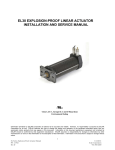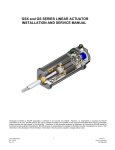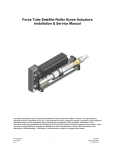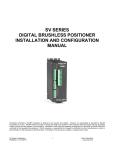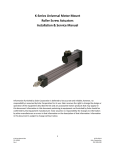Download ER series Installation & User Manual
Transcript
ER SERIES EXPLOSION-PROOF BRUSHLESS SERVO MOTOR INSTALLATION AND SERVICE MANUAL Class I, div 1, Groups B, C and D Hazardous Environment Rated Information furnished by EXLAR Corporation is believed to be accurate and reliable. However, no responsibility is assumed by EXLAR Corporation for its use. EXLAR reserves the right to change the design and operation of the equipment described herein and any associated motion products that may appear in this document. Information in this document pertaining to equipment not furnished by EXLAR should be confirmed by that equipment manufacturer. EXLAR assumes no responsibility for changes to information by other manufacturers or errors in that information or the description of that information. Information in this document is subject to change without notice. ER Manual.doc PN: 23943 Rev B 1 06/2011 Exlar Corporation 855-620-6200 TABLE OF CONTENTS 1.0 Introduction 1.1 Warranty and Limitations of Liability 1.2 Safety Considerations 1.3 Explosion-Proof Classifications 2.0 System Configuration 2.1 Typical System Configuration 2.2 Feedback Information 3.0 Installation and Operation 3.1 Mounting Configurations 3.2 Mounting Considerations 3.3 Output Torque Ratings 4.0 Specifications 4.1 Electrical/Mechanical Specifications 4.2 ER Series Motor and Gear Stage Inertia 5.0 Troubleshooting Procedures 6.0 Installation 6.1 Exlar ER115 with Exlar SV Series Digital Positioner ER Manual.doc PN: 23943 Rev B 2 06/2011 Exlar Corporation 855-620-6200 1.0 INTRODUCTION 1.1 Warranty and Limitation of Liability EXLAR warrants its product(s) to the original purchaser and in the case of original equipment manufacturers, to their original customer to be free from defect in material and workmanship and to be made in accordance with Exlar’s specifications for the product(s) as published at the time of purchase unless otherwise agreed to in writing by an authorized Exlar representative. In no event shall EXLAR be liable or have any responsibility under such warranty if the products have been improperly stored, installed, used or maintained, or if Buyer has permitted any unauthorized modifications, adjustments and/or repairs to such product(s). Seller's obligation hereunder is limited solely to repairing or replacing (at its option), at the factory, any product(s), or parts thereof, which prove to Seller's satisfaction to be defective materials or workmanship, and within the period of time in accordance with the seller's stated product warranty (see terms and conditions), however, that written notice of claimed defects shall have been given to EXLAR within 30 days from the date any such defect is first discovered. The product(s) or part(s) claimed to be defective must be returned to EXLAR, transportation prepaid by Buyer, with written specification of the claimed defect. Components such as seals, wipers, bearings, bushings, gears, splines and roller screws are considered wear parts and must be inspected and serviced on a regular basis. Any damage caused by failure to properly lubricate EXLAR products and/or to replace wear parts at appropriate times is not covered by this warranty. THE FOREGOING WARRANTY IS IN LIEU OF ALL OTHER WARRANTIES (EXCEPT AS TITLE), WHETHER EXPRESSED OR IMPLIED, INCLUDING WITHOUT LIMITATION, ANY WARRANTY OF MERCHANTABILITY, OR OF FITNESS FOR ANY PARTICULAR PURPOSE, OTHER THAN AS EXPRESSLY SET FORTH AND TO THE EXTENT SPECIFIED HEREIN, AND IS IN LIEU OF ALL OTHER OBLIGATIONS OR LIABILITIES ON THE PART OF EXLAR. SELLER'S MAXIMUM LIABILITY WITH RESPECT TO THESE TERMS AND CONDITIONS AND ANY RESULTING SALE, ARISING FROM ANY CAUSE WHATSOEVER, INCLUDING WITHOUT LIMITATION, BREACH OF CONTRACT OR NEGLIGENCE, SHALL NOT EXCEED THE PRICE SPECIFIED HEREIN OF THE PRODUCT(S), GIVING RISE TO THE CLAIM, AND IN NO EVENT SHALL EXLAR BE LIABLE UNDER THE TERMS OF THE WARRANTY OTHERWISE FOR SPECIAL, INCIDENTAL OR CONSEQUENTIAL LOSSES RESULTING FROM INABILITY TO USE THE PRODUCT(S), INCREASED OPERATING COST, LOSS OF PRODUCTION, LOSS OF SPECIAL INCIDENTAL OR CONSEQUENTIAL DAMAGES, WHETHER SIMILAR OR DISSIMILAR OF ANY NATURE ARISING OR RESULTING FROM THE PURCHASE, INSTALLATION, REMOVAL, REPAIR, OPERATION, USE OR BREAKDOWN OF THE PRODUCT(S), OR ANY OTHER CAUSE WHATSOEVER INCLUDING NEGLIGENCE. The foregoing warranty shall apply to products or parts that have been repaired or replaced pursuant to such warranty, and within the period of time, in accordance with the Seller's stated warranty. No person including any agent of EXLAR, is authorized to make any representation of warranty on behalf of EXLAR concerning any products manufactured by EXLAR, except to refer to this warranty. ER Manual.doc PN: 23943 Rev B 3 06/2011 Exlar Corporation 855-620-6200 1.2 Safety Considerations As with any electro-mechanical device, safety should be considered during the installation and operation of your ER Series brushless servo motor. Throughout this manual you will see paragraphs marked with CAUTION and WARNING signs as shown below. CAUTION WARNING Pay particular attention to these paragraphs. They are intended to provide you with helpful information to ensure safe and trouble-free installation. 1.3 Explosion-Proof Ratings ER Series motors are rated for Class 1, div 1, Groups B, C and D. The classification of "Class 1" means that flammable gases or vapors may be present in the air in quantities sufficient to produce explosive or ignitable mixtures. "Division 1" means that hazardous concentrations in the air may exist continuously, intermittently, or periodically under normal operating conditions. "Group B" allows for atmospheres containing hydrogen, or gases (or vapors) of equivalent hazard, such as manufactured gas. "Group C" allows for atmospheres containing ethyl-ether vapors, ethylene or cyclo propane. "Group D" allows for atmospheres containing gasoline, hexane, naptha, benzene, butane, alcohol, acetone, benzol, lacquer solvent vapors, or natural gas. ER Series motors are not rated for operation in atmospheres containing acetylene. It is the responsibility of the user to provide for properly rated conduit connections to the ER Series motor or gearmotor. Exlar takes no system responsibility beyond the motor or gearmotor ratings. ER Manual.doc PN: 23943 Rev B 4 06/2011 Exlar Corporation 855-620-6200 2.0 SYSTEM CONFIGURATION 2.1 ER Series Servo Motor System Configuration The design of the ER Series motor and selection of the proper feedback configuration allows it to be powered by nearly any brand of brushless motor amplifier on the market that powers brushless motors with resolver feedback. Each brand of brushless motor amplifiers may have unique wiring requirements, parameter settings and operational principles that affect how the motor operates. Details on connections to specific brands of amplifiers can be obtained from Exlar applications engineering or from Section 6.0. Never attempt to connect or disconnect the motor with power applied. Dangerous voltages are present. Damage to equipment and injury to personnel can result. Many amplifiers have voltage present for a considerable time period after incoming power is removed. Take care to insure that the amplifier has discharged all power. Typical System Connections ER Manual.doc PN: 23943 Rev B 5 06/2011 Exlar Corporation 855-620-6200 2.2 Feedback Information Standard ER Series motors use resolvers as their primary feedback device. Depending on the amplifier that will be used to operate the actuator, the hookup of the actuator can vary. Always consult Section 6.0 for proper wiring, or contact Exlar for the correct wiring details. Most ER Series motors incorporate a 2 pole resolver with commutation signals as the primary rotary feedback device. The selection of this feedback device is dictated by the amplifier that the end user will use to operate the motor. This amplifier is indicated in the model number of the ER Series motor as a 3 digit code consisting of 2 letters and 1 number. Each amplifier has specific requirements for the feedback on the motor. Not all resolver-based amplifiers can use the same resolver, resolver alignment, or relative direction of resolver rotation. Many amplifiers offer software that allows the entering of parameters or the downloading of "motor data files" that dictate how the feedback must be set up on the motor. Exlar can provide many of these "data files" or the proper parameters to enter. Entering motor parameter data to some amplifiers may require assistance from the amplifier manufacturer. Feedback Alignment When Exlar manufactures an ER Series motor, the proper feedback is selected, mounted, aligned and test run on the amplifier that the customer plans to use, or one that is known to be equivalent for confirming proper feedback alignment and operation. In any case where it is determined that the feedback has become mis-aligned, or an amplifier change is made requiring the feedback to be aligned differently, it is recommended that Exlar be contacted and arrangements made to have that procedure performed. Feedback Wiring The wiring of the feedback device is critical to the operation of the motor with the selected amplifier. Miswiring the feedback cable can cause unstable operation, incorrect operation or no operation at all. In some cases, if the proper current limits are not set in the amplifier, mis-wiring of the feedback cable can lead to damage of the motor. Resolvers A resolver is a non-electronic device that works like a small transformer. When rotated, it generates two sine waves that are out of phase with one another. By decoding these two sine waves, the amplifier can monitor the direction, revolutions traveled and speed of rotation of the motor. Each sine wave typically represents one revolution of the motor, so the amplifier can also use these signals to know where the motor is within that revolution. By knowing the motor's position, the amplifier can properly time the supply of current and voltage to the motor for it to rotate. This process is commutation. For the amplifier to properly commutate the motor, it must have a reference, or zero, point from which to track the motor's rotation. This reference point is critical, and is provided to the amplifier through the proper alignment of the resolver to the phases of the motor during the actuator assembly. ER Manual.doc PN: 23943 Rev B 6 06/2011 Exlar Corporation 855-620-6200 3.0 INSTALLATION AND OPERATION 3.1 Mounting Configurations The ER Series standard mounting configurations and dimensions can be obtained from the product catalog or from our website, www.exlar.com. The typical fasteners used to mount via the front through holes of the ER Series actuators are: ER 115: M8 or 5/16” SHCS 3.2 Mounting Considerations As with any motor product, misalignment of the ER Series motor with respect to whatever load the motor is being used to move is of great concern. Any misalignment will decrease the life of the components within the motor and also may create problems within the application associated with misalignment. Therefore every effort should be made to minimize misalignment as much as is possible. Also, mounting of pulleys and similar devices on the output shaft of the motor imparts side load on the output shaft. The life of the gear stage of the actuator is dependant on side load as shown in the table below. Visit www.exlar.com for more detailed tables. ER115 Radial Load for 10,000 hour bearing life at 25mm from motor face RPM 50 100 250 500 Lbf (N) 939 (4177) 745 (3314) 549 (2442) 435 (1935) 1000 346 (1539) Excessive side load on the output shaft of the motor will dramatically reduce the life of the motor and should be avoided. Side load can be caused from misalignment, loading from devices such as pulleys mounted directly to the output shaft, and from the motor’s use in the application. ER Manual.doc PN: 23943 Rev B 7 06/2011 Exlar Corporation 855-620-6200 3.3 Output Torque Ratings ER Series gearmotors are equivalent to ER Series motors with integrated planetary gearing. Consult ER Series electrical and speed torque data for use with ER ratios. The maximum allowable output torque for the ER Series motors is shown below. It is the user’s responsibility not to exceed the acceptable output torque of the ER Series gearmotor. Output Torque Ratings Output Torque @ Indicated RPM for 10,000 Hour Life Ratio ER115 ER Manual.doc PN: 23943 Rev B 4:1 5:1 10:1 16:1 20:1 25:1 40:1 50:1 100:1 Maximum Static Load Lbf-in (Nm) 4696 (530.4) 4066 (459.4) 2545 (287.5) 4696 (530.4) 4696 (530.4) 4066 (459.4) 4696 (530.4) 4066 (459.4) 2545 (287.5) 1000 RPM Lbf-in (Nm) 1392 (157.3) 1445 (163.3) 1660 (187.6) 2112 (238.6) 2240 (253.1) 2350 (265.5) 2800 (316.4) 2900 (327.7) 2500 (282.5) 8 2000 RPM Lbf-in (Nm) 1132 (127.9) 1175 (132.8) 1350 (152.6) 1714 (193.0) 1840 (207.9) 1900 (214.7) 2240 (253.1) 2350 (265.5) 2500 (282.5) 3000 RPM Lbf-in (Nm) 1000 (112.9) 1040 (117.5) 1200 (135.6) 1518 (171.0) 1620 (183.0) 1675 (189.2) 2000 (225.9) 2100 (237.3) 2400 (271.2) 06/2011 Exlar Corporation 855-620-6200 4.0 SPECIFICATIONS 4.1 Electrical/Mechanical Specifications ER115 Mechanical/Electrical Data MOTOR STATOR 1A8 1B8 118 138 158 168 2A8 2B8 238 258 268 338 358 368 50.5 50.5 50.6 50.5 83.3 83.3 84.0 82.5 84.0 117.3 117.6 120.4 RMS Sinusoidal Commutation Data Continuous Motor Torque* Lbf-in 49.7 49.7 Peak Motor Torque Torque Constant (Kt) (N-m) 5.61 5.61 5.70 5.70 5.72 5.70 9.41 9.41 9.49 9.32 9.49 13.25 13.29 13.60 Lbf-in 99.3 99.3 101.0 101.0 101.2 100.9 166.6 166.6 168.0 165.0 168.0 234.6 235.3 240.8 (N-m) 11.22 11.22 11.41 11.41 11.44 11.40 18.82 18.82 18.98 18.64 18.98 26.50 26.58 27.21 8.7 15.7 17.4 5.3 5.3 8.7 15.9 17.4 8.5 15.9 17.6 Lbf-in/A 5.3 5.3 4.3 0.6 0.6 0.5 1.0 1.8 2.0 0.6 0.6 1.0 1.8 2.0 1.0 1.8 2.0 Cont. Current Rating @ 80°C A 10.5 10.5 13.0 6.5 3.6 3.2 17.6 17.6 10.8 5.8 5.4 15.4 8.3 7.7 Peak Current Rating @ 80°C A 21.0 21.0 26.0 13.0 7.2 6.5 35.2 35.2 21.6 11.6 10.8 30.8 16.6 15.3 +/-10% @ 80°C N-m/A Trapezoidal Commutation Data Continuous Motor Torque 47.4 47.4 48.2 48.2 48.3 48.2 79.5 79.5 80.2 78.8 80.2 112.0 112.3 115.0 5.36 5.36 5.45 5.45 5.46 5.45 8.99 8.99 9.06 8.90 9.06 12.66 12.69 12.99 230.0 Lbf-in 94.8 94.8 96.4 96.4 96.7 96.4 159.1 159.1 160.4 157.6 160.4 224.0 224.7 (N-m) 10.71 10.7 10.9 10.9 10.9 10.9 18.0 18.0 18.1 17.8 18.1 25.3 25.4 26.0 Lbf-in/A 4.12 4.12 3.39 6.78 12.22 13.55 4.12 4.12 6.78 12.37 13.55 6.63 12.37 13.70 (N-m/A) 0.47 0.47 0.38 0.77 1.38 1.53 0.47 0.47 0.77 1.40 1.53 0.75 1.40 1.55 Peak Motor Torque Torque Constant (Kt) +/-10% @ 80°C Lbf-in (N-m) Cont. Current Rating @ 80°C A 12.85 12.85 15.90 7.95 4.42 3.97 21.55 21.55 13.23 7.12 6.61 18.88 10.14 9.38 Peak Current Rating @ 80°C A 25.69 25.69 31.81 15.90 8.84 7.95 43.10 43.10 26.46 14.23 13.23 37.76 20.29 18.76 51.1 51.1 42.0 83.9 151.4 167.9 53.1 51.1 83.9 153.3 167.9 82.1 153.3 169.7 36.1 36.1 29.7 59.4 107.1 118.7 36.1 36.1 59.4 108.4 118.7 58.1 108.4 120.0 8 8 8 8 8 8 8 8 8 8 8 8 8 8 Ohms 0.31 0.31 0.20 0.80 2.60 3.21 0.127 0.13 0.34 1.17 1.35 0.20 0.69 0.81 mH 4.8 4.8 3.3 13.0 42.4 52.1 2.3 2.3 6.3 21.1 25.3 4.0 13.9 17.1 Motor Stator Data Voltage Constant (Ke) Vrms / Krpm +/-10% @ 80°C Vpk / Krpm Pole Configuration Resistance (L-L) +/-5% Inductance (L-L) +/-15% Armature Inertia lbf-in-sec2 0.00555 Kg-cm2 Mech. Time Constant (tm), ms min 6.27 0.53 0.53 0.52 0.54 0.52 0.43 0.42 max 15.73 15.73 16.26 16.26 16.34 16.25 18.41 18.41 18.72 18.06 18.72 20.08 20.19 21.16 ms 15.73 15.73 16.26 16.26 16.34 16.25 18.41 18.41 18.72 18.06 18.72 20.08 20.19 21.16 lbf-in/krpm 0.21 0.21 0.21 0.21 0.35 0.35 0.35 0.35 0.35 0.40 0.40 (N-m/krpm) 0.024 0.024 0.024 0.024 0.024 0.024 0.040 0.040 0.040 0.040 0.040 0.045 0.045 0.045 lbf-in Bus Voltage Vrms Speed @ Bus Voltage RPM Motor Wire Insulation °C (class) 0.56 0.21 0.56 0.82 12.56 0.82 (N-m) 0.85 9.42 0.82 Friction Torque 0.85 0.01112 0.82 Electrical Time Constant (te) Damping Constant 0.00833 0.21 0.56 0.56 0.56 1.00 1.00 1.00 1.00 1.00 1.20 1.20 0.063 0.063 0.113 0.113 0.113 0.113 0.113 0.136 0.136 0.136 300 750 115 230 400 460 3000 3000 3000 3000 24VDC 48VDC 300 750 1.20 230 400 460 230 400 460 3000 3000 3000 3000 3000 3000 180(H) Insulation System Voltage Rating Thermal Switch, case temp. 0.40 0.063 0.063 0.063 0.063 24VDC 48VDC 0.56 0.40 460 °C 100 IP65 Environmental Rating *For amplifiers using peak sinusoidal ratings, multiply RMS sinusoidal Kt by .707, and peak current by 1.414. Test data derived using NEMA 12" x 12" x 1/2" aluminum heat sink ER Manual.doc PN: 23943 Rev B 9 06/2011 Exlar Corporation 855-620-6200 4.2 ER Series Gearmotor Stage Inertia ER115 Stator 1 Stack 2 2 2 Stack 3 Stack ER Armature Inertia lb-in-sec (kg-m ) 0.00344 (3.89) 0.00623 (7.036) 0.00901 (10.181) ER Brake Inertia lb-in-sec2 (kg-m2) 0.00327 (3.70) 0.00327 (3.70) 0.00327 (3.70) 0.00538 (6.08) 0.00816 (9.22) 0.0109 (12.37) 2 2 ER Armature Inertia lb-in-sec (kg-m ) Reflected Inertias Single Reduction 2 2 Reflected Inertias Double Reduction Gear Stages lb-in-sec (kg-cm ) Gear Stages lb-in-sec2 (kg-cm2) 4:1 0.000635 (0.717) 16:1 0.000513 (0.580) 5:1 0.000428 (0.484) 20:1, 25:1 0.000350 (0.396) 10:1 0.000111 (0.125) 40:1, 50:1, 100:1 0.0000911 (0.103) 5.0 TROUBLESHOOTING PROCEDURES This section provides you with guidelines and hints on troubleshooting various problems that may be encountered during installation and operation of your Exlar ER Series motor. Symptom / Trouble Possible Cause / Troubleshooting Procedure No response from motor. 1. Check amplifier for faults that may indicate problem. 2. Check to insure that amplifier is enabled 3. Check for proper wiring 1. Amplifier may be improperly tuned. Check all gain settings. If a motor file, or parameters specific to your amplifier/motor combination have been supplied by Exlar, be sure that they are entered or downloaded properly. 2. Amplifier may be set up improperly for the particular motor being used. Check amplifier settings for number of poles, voltage, current, resistance, inductance, inertia, 3. Feedback wiring may be incorrect. 4. Feedback conductors touching, or feedback cable may be damaged. 5. Motor phases are wired incorrectly or in incorrect order. (R,S,T) 6. Resolver feedback is improperly aligned. Contact Exlar. 1. Load is too large for the capacity of the motor or too much friction is present. 2. Excessive side load. 3. Misalignment of output shaft to load. 4. Amplifier has too low of current capacity or is limited to too low of current capacity. 1. Check motor mounting. Insure that the motor is securely mounted. 2. Amplifier is improperly tuned (wrong gain settings.) Tune amplifier. Motor seems to be enabled (receiving current) but is not operating or is operating erratically. Motor cannot move load Motor housing moves or vibrates when shaft is in motion. Motor is overheating 1. Insufficient cooling for application requirements. Contact Exlar engineering. 2. Motor is being operated outside of continuous ratings. 3. Amplifier is poorly tuned causing excessive unnecessary current to be applied to motor. Check Gain settings. 6.0 SYSTEM INSTALLATION ER Manual.doc PN: 23943 Rev B 10 06/2011 Exlar Corporation 855-620-6200 DRIVE SET-UP WITH ER SERIES MOTORS This section provides you with cable and wiring information for operation of your ER Series motor with Exlar's SV Series Digital Positioner. (NOTE: If you use a different amplifier, contact Exlar for assistance.) 6.1 Exlar ER115 with SV Series Positioner Resolver Feedback Power FOR DETAILED SETUP INSTRUCTIONS SEE THE SV SERIES INSTALLATION AND CONFIGURATION MANUAL. ER Manual.doc PN: 23943 Rev B 11 06/2011 Exlar Corporation 855-620-6200











